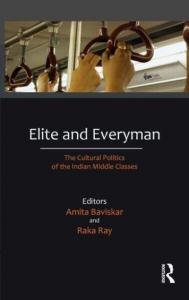Berkeley Books: Elite and Everyman: The Cultural Politics of the Indian Middle Class

By the broadest metric available, is is estimated that the top 26 percent of Indian households belong to the middle class. This means, effectively, that about 70 percent of Indian households live below the middle class, with 40 percent or more of these being below the poverty line. And yet, when one reads about Indian ascendancy in the game of geopolitics and capital--especially when one reads news directly from Indian political mouthpieces, the concerns are decidedly middle class.
This ascendancy of the Indian middle classes signifies a drastic change in both Indian cultural and political life. Its roots can, perhaps, be traced to the rapid economic liberalization of the 1990s, introducing market forces into economic areas previously controlled by the state. At the core of these initiatives was a concept borrowed from much Western thinking: the middle classes serve as the engine of change.
This month's Berkeley Book, Elite and Everyman: The Cultural Politics of the Indian Middle Classes, co-edited by Raka Ray and Amita Baviskar, starts with just this consideration. "In Marx's historical explanation for the development of Capitalism in Europe," they write in the introduction, "the bourgeoisie was a revolutionary class that broke through feudal social relations 'not only [to] transform the economic processes and structure of the society, but [also] reshape its politics and fundamentally rework the values that dominates in the society.' The French writer Alexis de Tocqueville, visiting America in the 19th century, claimed that the strength of America's democracy derived from its prosperity and the possibility of upward mobility...the middle classes...were the mainstay of American democracy". It continues, "while there are studies which question the assertion that the middle classes form the primary link between capitalism and democracy, claims about the progressive role of the middle class in the past, present, and future of political and social change in India are widespread and influential. They demand careful scrutiny, especially given the lack of clarity about the term 'middle class'".
Indeed, who and what defines the Indian middle class? And, from this, is it possible to ascribe to them the possibility of facilitating broad social, economic, and political change? This month's Berkeley Book, Elite and Everyman: The Cultural Politics of the Indian Middle Classes, poses just these questions. This collection of essays asks us who these middle class people are, how they become and participate in middle class-ness, and what politics they set forth in the public sphere. Looking to such diverse objects as computer use, sex surveys, censorship programming, and sectorial composition, these essays attempt to understand the middle class as a variegated, complex set of individuals, goals, and positions. Rather than fall back on well-worn cliché, this collection offers startling insight into the Indian middle class in addition to thought-provoking challenges to the base implantation of Western class discourse onto a decidedly non-Western space.
Raka Ray, co-editor of this volume, is Professor of Sociology and South and Southeast Asia Studies and Chair of the Center for South Asia Studies. Her previous books include Fields of Protest: Women’s Movements in India (1999); Social Movements in India: Poverty, Power, and Politics (co-edited with Mary Katzenstein in 2005); and, co-written with Seemin Qayum, Cultures of Servitude: Modernity, Domesticity and Class in India (2009). Her areas of specialization include gender and feminist theory, domination and inequality, and cultures of servitude and social movements.
Visit the Biblio-file to view books that shaped Professor Ray's thoughts while working on Elite and Everyman.
Sanjay Hukku is a Graduate Student Researcher at the Townsend Center for the Humanities